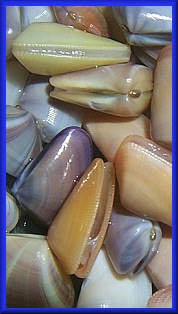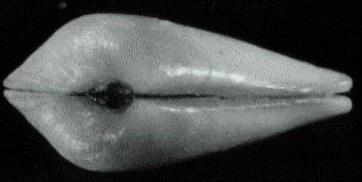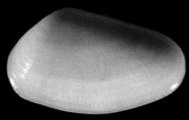| A New-Old Species for the N. E. Florida Checklist | |
| By Harry G. Lee | |
 Admittedly it has gotten a bit difficult to find mollusks to add to our on-going Jacksonville Shell Club Northeast Florida Checklist. We've had to exploit less accessible habitats (usually below 100 ft. depths) and obscure (under 5 mm. in most cases) taxa for the last ten percent of our present grand total of 522 species.* The following experience convinced me that even the most mundane and simple shelling can produce rewarding and unexpected results. For a few years I had either read (Morrison, 1971) or been told of the existence of two separate species of coquina (Donax or "periwinkles" local beach residents call them) clams occurring on our beaches. I think the first notice came from Mrs. Connie Boone of Houston, who spoke with me at the 1980 Shell Show banquet. It seems she was in quest of topotypes (specimens from the type locality) of Donax parvulus Philippi, 1849. What amazed me was that she planned to get them in front of Howard Johnsons-by-the-Sea, and I had none in my collection. A year later Paul Mikkelsen, who, with his wife Paula, was exhibiting at the Shell Show, mentioned his interest in Donax and rekindled my fascination with D. parvulus. He was quite convinced that there were two species "out there" and had spent many hours studying Donax on southeastern beaches. Paul provided me with Joe Morrison's 1971 study on Western Atlantic Donax, and I tried to familiarize myself with the ten species which occur from Long Island to Uruguay. Digging in the intertidal areas of Crescent Beach (near St. Augustine), I was able to find Donax in culinary quantities during the warmer months of 1981 and 1982 but could not be sure, even with Morrison's paper in hand, that I had anything other than the familiar Donax variabilis Say, 1822 among the thousands of living clams I'd harvested. Since coquina broth is tasty, the research was always rewarding, but eventually the conchological results became irksome. Accordingly I decided to employ a more scientific approach. Five months ago I visited the same beach at extremely low tide and made a transect. By working at right angles to the water's edge I sifted about ten double handfuls of sand at intervals of about twenty feet. I was pleased to find two concentrations of living coquinas - one near the water's edge and one almost one hundred feet inland in the mid-tide zone. Surprisingly few examples occurred between the two enclaves. I then concentrated my attention on the two populous samples of clams. The living animals appeared identical as they deployed their siphons and spade-like feet in small buckets of seawater. Each anatomic part was a homogeneous cream color. On the other hand, the shells of the sample from the lower zone were smaller and less colorful than those from near the mid-tide line. Closer examination of the shells produced an exciting revelation. The vast majority of the shells comprising the lower sample (in fact 153 of 156 specimens) conformed to the description of D. parvulus whereas 117 of 122 from the mid-tide sample were D. variabilis. The later species has more conspicuous radial sculpture and posterior ridge - simple! Further differences include the occurrence of rayed shells in populations of D. variabilis and NOT D. parvulus and a difference in the shape of the hinge ligament. Well, it wasn't that easy when I had examined shells on previous occasions. My error had been to assume that the D. parvulus were the babies. This time the availability of nearly "pure" lots allowed for (1) the appreciation of the consistency of the shell characteristics and (2) the comparison of shells of the same size belonging to each species. A precious few of the D. variabilis youngsters were in the size range of the typical parvulus, about 7.5mm. The shell differences were just as vivid at this size as with the bulk of the sample (D. variabilis being about twice as big as D. parvulus). This ecological "zonation" of cohabiting D. variabilis and D. parvulus populations has been discussed by Morrison and others. Furthermore, the lumping of the two species in collections made throughout their common range (North Carolina to S.E. Florida) was almost characteristic even in the Smithsonian holdings. Until 1971 most, maybe all, collectors were content to consider D. parvulus as a juvenile D. variabilis. It took careful conchological study and ecological field work for Dr. Morrison to sort out this problem. He apparently was so pleased with the local colony of D. parvulus that he designated Jacksonville Beach as the type locality. Other species for which Jacksonville is the type locality include Helicina (Olygyra) orbiculata (Say) and Praticolella jejuna (Say). Clearly the species is no newcomer as I was later able to find fossil specimens at Washington Oaks State Park (Flagler Co.) and in the walls of Castillo de San Marcos in St. Augustine! North of Cape Hatteras there is a coquina with habits quite like D. parvulus. I collected this fellow, Donax fossor Say, 1822, in June 1957 at Stone Harbor, N.J. The shells of the two are very similar with D. fossor being slightly more squared-off posteriorly. Dr. T. E. Pulley (1979) feels that the two are undifferentiable, and Morrison (1971) does not offer a convincing argument for their separation. I shall straddle the taxonomic issue and hereby designate our little coquina Donax fossor parvulus Philippi, 1849 and place it on our checklist of marine mollusks. |
|
 |
 |
 |
 |
|
Donax parvulus (L.) and Donax variabilis (R.) - both 7.5 mm. |
|
| *As of January 17, 2005, the total is 798 species | |
| Literature cited: | |
| Morrison, J. P. E. (1971) Proc. Biol. Soc. Washington 83(48): 545-568. | |
| Pulley, T. E. (1979) Texas Conchologist 15(2): 26-35. | |